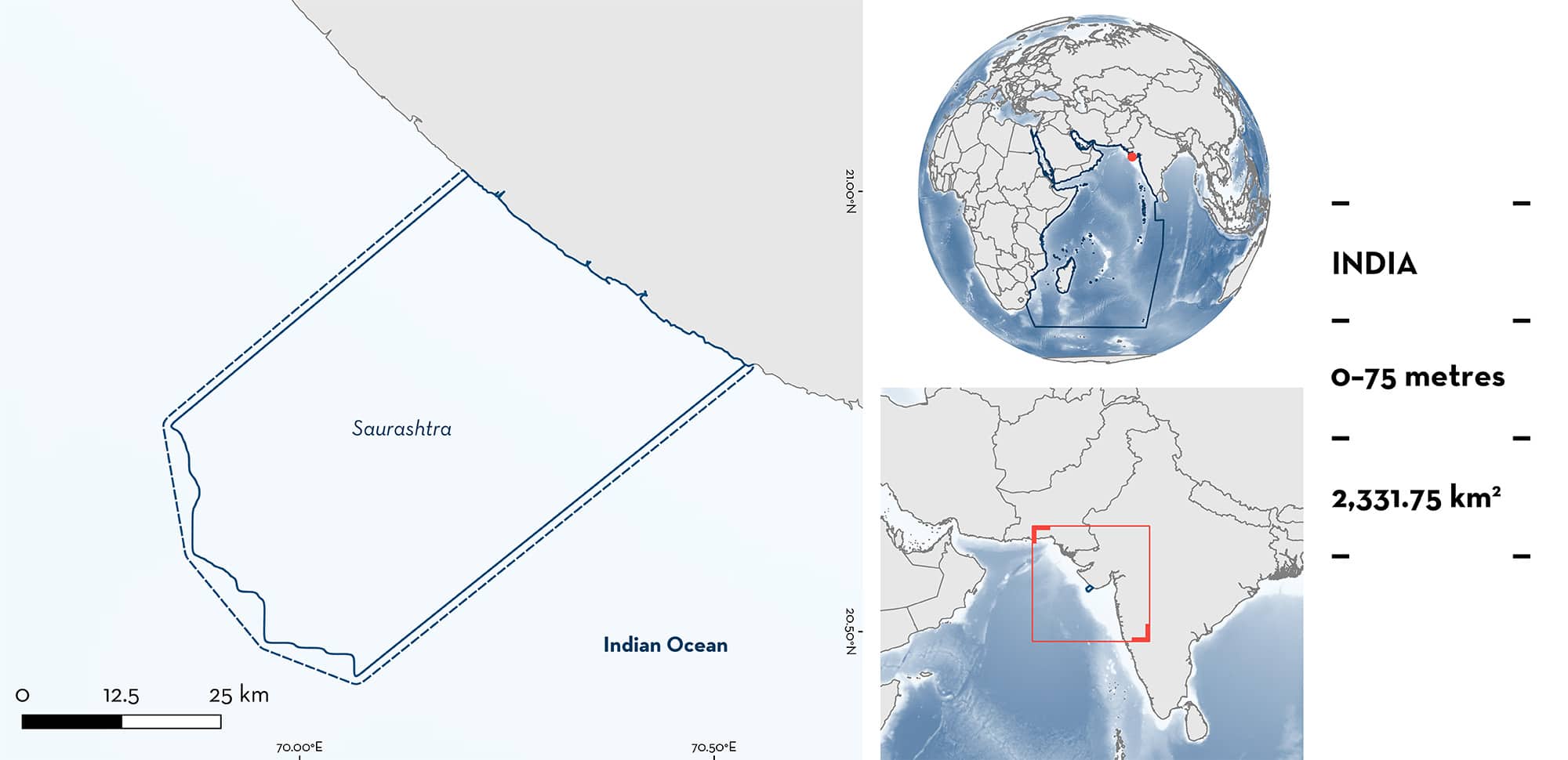ISRA FACTSHEETS
ISRA FACTSHEETS
WESTERN INDIAN OCEAN REGION
Saurashtra
Summary
Saurashtra is located on the continental shelf of Gujarat on the west coast of India. The region is characterised by the widest continental shelf of the eastern Arabian Sea. The area comprises epipelagic waters over sandy or muddy substrates. The area is known for its high productivity especially during the post-monsoon season and during the boreal winter due to winter convective mixing. Within the area there are: threatened species and reproductive areas (Whale Shark Rhincodon typus).
Download factsheet
Saurashtra
DESCRIPTION OF HABITAT
Saurashtra is located on the continental shelf off Gujarat State on the west coast of India. The Saurashtra Peninsula (also known as Kathiawar Peninsula) is bounded by two large gulfs – the Gulf of Kutch (also known as the Gulf of Kachchh) to the north and the Gulf of Khambhat to the south. The area covers shelf waters between Porbandar in the north to Sutrapada in the south. The region surrounding the state of Gujarat is characterised by the widest continental shelf of the eastern Arabian Sea (Solanki et al. 2005; Faruque & Ramachandran 2014; Solanki et al. 2017). The area comprises epipelagic waters over sandy or muddy substrates.
The waters are highly productive due to the boreal winter convective mixing especially during the post-monsoon season (October) and during winter (November–February) (Madhupratap et al. 2001). During these seasons, the sea surface temperature is lower than in the rest of the year (Madhupratap et al. 2001). Higher levels of primary production (Chlorophyll-a) during winter months (Shalin et al. 2018; Goes et al. 2020) are distinct characteristics of Saurashtra compared to regions to the south in the southeast Arabian Sea.
This Important Shark and Ray Area is pelagic and is delineated from surface waters (0 m) to 75 m based on the bathymetry of the area and the occurrence of the Qualifying Species.
CRITERION A
VULNERABILITY
The one Qualifying Species within the area is considered threatened with extinction according to the IUCN Red List of Threatened SpeciesTM. The Whale Shark is assessed as Endangered (Pierce & Norman 2016).
CRITERION C
SUB-CRITERION C1 – REPRODUCTIVE AREAS
Saurashtra is an important area for the reproduction of one shark species.
Reproductive areas, such as mating and pupping grounds, are among the lesser-known attributes of Whale Shark life history and only a very limited number of individuals < 150 cm total length (TL) have been reported globally (Miranda et al. 2021). Saurashtra is one of the few places globally where neonates have ever been recorded. Recent records include four neonates in the size range of 60–100 cm TL recorded in 2013 (Matwal et al. 2014; Premjothi et al. 2016b). Dates of these records were 05 March 2013 (10 km off Sutrapada), 15 March 2013 (~10 km off Sutrapada), 06 April 2013 (found dead on a beach near Sutrapada), and 2013 (no accurate date given; 20 km off Sutrapada) (Premjothi et al. 2016b). A 50 cm TL neonate was released from a fishing net on 18th February 2017 at a distance of 52 km off Sutrapada (WTI 2017). The reported size-at-birth of the species is 55–64 cm TL (Ebert et al. 2021). The documentation of several neonate Whale Sharks is globally significant and suggests that Saurashtra is a pupping site for the species (Matwal et al. 2014; Premjothi et al. 2016b).
The area historically supported a Whale Shark fishery before the species was protected in India (Pravin 2000; Hanfee 2001; Joshi et al. 2007; Akhilesh et al. 2013; Premjothi et al. 2016a). Local numbers were depleted due to the fishery, but despite this, Whale Sharks still regularly occur in the area (e.g., eight sharks of 540–800 cm TL satellite-tagged out of Veraval on the Saurashtra Peninsula between 2011 and 2017; Arrowsmith et al. 2021).
Several environmental parameters are known to influence the movements and aggregations of Whale Sharks. High primary production and thermal fronts are proposed as major environmental drivers of aggregations or frequent sightings (Sleeman et al. 2010; Ryan et al. 2017; Meekan et al. 2020; Arrowsmith et al. 2021). The waters of Saurashtra are known for their unique winter convective mixing characterised by lower sea surface temperature and enhanced primary production (Madhupratap et al. 2001; Shalin et al. 2018; Goes et al. 2020). A relationship has been documented between Gujarat Whale Shark landings and these environmental parameters across a study period of February to March 1998 to 2000 (Kumari & Raman 2010). It is possible that the occurrence of Whale Sharks, including pupping grounds, is linked to higher food availability along the coastline in the area due to these environmental factors (Arrowsmith et al. 2021).
Download factsheet
SUBMIT A REQUEST
ISRA SPATIAL LAYER REQUEST
To make a request to download the ISRA Layer in either a GIS compatible Shapefile (.shp) or Google Earth compatible Keyhole Markup Language Zipped file (.kmz) please complete the following form. We will review your request and send the download details to you. We will endeavor to send you the requested files as soon as we can. However, please note that this is not an automated process, and before requests are responded to, they undergo internal review and authorization. As such, requests normally take 5–10 working days to process.
Should you have questions about the data or process, please do not hesitate to contact us.


